Pull ups are one of the best bodyweight exercises to build back and core strength because they are a compound movement.
However, they are also one of the most challenging bodyweight exercises for most people to do.
If you are struggling to achieve that first full pull up or would simply like to be able to do more, check out our How To Do A Pull Up Guide below.
In this guide we will help you get the big muscles of your back working properly and show you pull up variations and supplemental exercises to improve your strength and get your chin up over that bar!
How To Do A Pull Up
Before you can even start doing pull ups or strengthening the muscles involved in doing pull ups, you’ve got to get your body ready to work properly.
If the big muscles of your back aren’t activated and ready to work, you aren’t going to be able to lift your chin up over that bar for near as many repetitions as you would like.
That is why your pull up workouts need to start with Foam Rolling, Stretching and Activation before you even start your strength training workout.
Foam Rolling To Improve Your Pull Ups
Foam rolling loosens up tight muscles from sitting hunched over a computer all day so that the big muscles of our back are ready to work when we do pull ups. If we don’t first loosen up tight muscles, we may not actually be engaging the correct muscles when we do a pull up.
If the big muscles of our back aren’t working, not only will we not be able to do as many pull ups as we would like, but we also risk getting injured.
Before you start doing pull ups, try these 6 Upper Body Foam Rolling Moves. These moves will loosen up your chest and lats, which are often tight from sitting hunched over all day. They will also improve your thoracic extension and loosen up your upper traps so that the big muscles of your back can be activated.
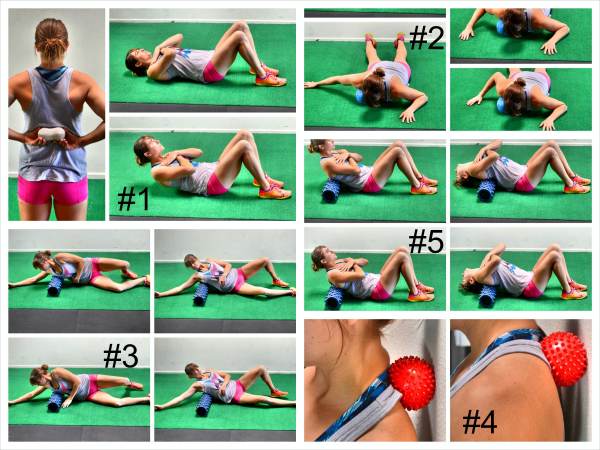
Stretches To Include In Your Pull Up Program
Once you’ve foam rolled, you need to stretch so everything is ready to work. Stretching helps open up tight muscles and return them to their proper length-tension relationships.
This will then allow you to activate the muscles of your back so that they work and you don’t risk getting a shoulder or neck injury.
Some stretching moves you need to include in your pull up warm up are:
– Standing Chest Stretch – Using a doorway, wall or pole, place one hand back on the wall or doorway with your arm out straight behind you.
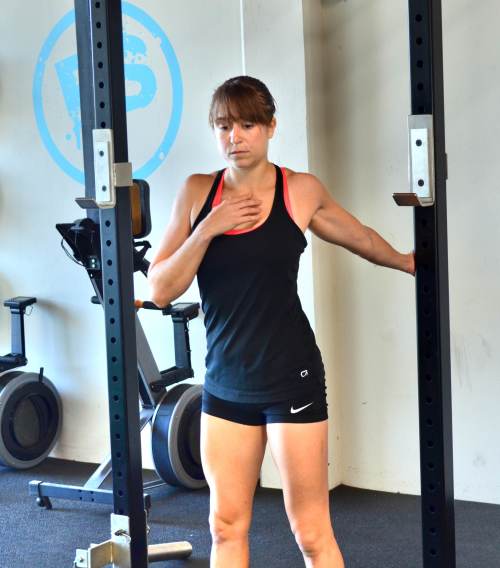
Turn away from the hand on the wall or door so that you feel a nice stretch down the front of your chest and shoulder. Stand up nice and tall and breathe.
You can also rotate the thumb back so your palm is facing toward the ceiling to hit a slightly different aspect and open up your chest and shoulder.
Make sure to stand tall and not round forward as you stretch. Hold for about 5-10 slow deep breathes and then switch sides.
This is even an easy stretch to do any time you walk through a doorway!
– Fish – This is another great chest and shoulder stretch.

To do the Fish pose, lie on your back on the ground with your legs out straight in front of you and your arms by your sides.
Then bend your elbows and prop yourself up on your forearms. Drive your chest up and out as you relax your head back and feel the stretch across your chest and shoulders.
You can either hold the stretch or complete reps, relaxing and then stretching again. It isn’t a big movement, but you do want to focus on opening your chest up toward the ceiling and feeling a stretch through your chest and shoulders.
Do not arch your low back to try to get your chest more open. The range of motion isn’t important. Just make sure you feel the stretch.
– Child’s Pose with Reaches – This is a great stretch for your lats as well as your low back and SI Joint. You may even feel it in your quads and ankles depending on your flexibility.

Point your toes and sit back on your heels as you reach your arms out straight in front of you on the ground. Relax and reach out as far as you can with your hands.
Then walk your hands to one side. Breathe and feel a stretch down your sides and into your low back. Then walk your hands back center and to the other side.
Do not let your butt come forward off your heels as you stretch.
– Thread The Needle – To do this stretch, kneel on the ground. Lean forward, relaxing the side of your head down onto the ground as you reach one arm overhead.
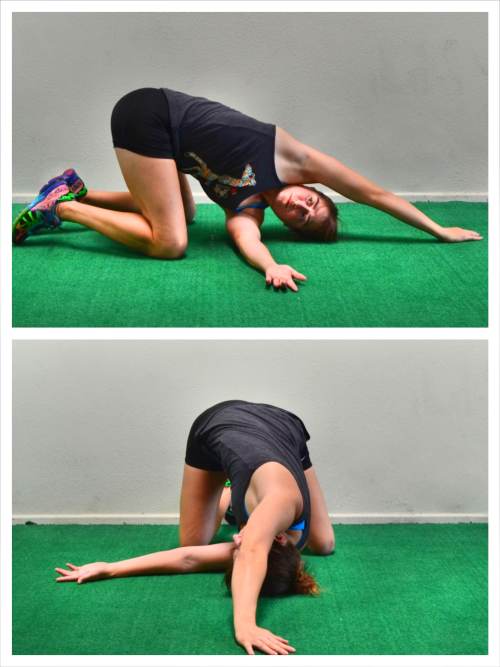
Reach the other arm under your body and toward the direction you are facing as if “threading a needle.” Relax that shoulder down toward the ground with your head on the ground and then rotate your chest up and open. You can reach your top arm up overhead and even try to walk the hand up and backward behind you. Hold and then thread the other arm under and through.
Feel a nice stretch between your shoulder blades and even down your neck and trap. Hold each stretch for a second or two before switching.
Do not sit back on your heels if you can’t drop your head and shoulder to the ground.
Pull Up Activation Exercises
Possible the most important, but most often ignored piece of learning how to do a pull up, is activation. Activation exercises get the correct muscles working for your pull ups so that you are able to do more!
Below are a few great activation moves. You do not need to do them all before your pull up workouts, but you should include at least a few. You want to feel your back muscles working and engaged before you even attempt your first pull up.
These moves will activate your lower traps and rhomboids so that your lats work when you do pull ups instead of your upper traps and shoulders. Make sure you feel these moves low between your shoulder blades and down the sides of your back. You do not want to feel these moves in your shoulders and neck.
– Scapular Wall Hold – One of the best back activation moves out there and one you can do ANYWHERE. This is a great way to get your lower traps and rhomboids working while also stretching out your pecs and anterior deltoid. Click here for instructions on how to do the Scapular Wall Hold.
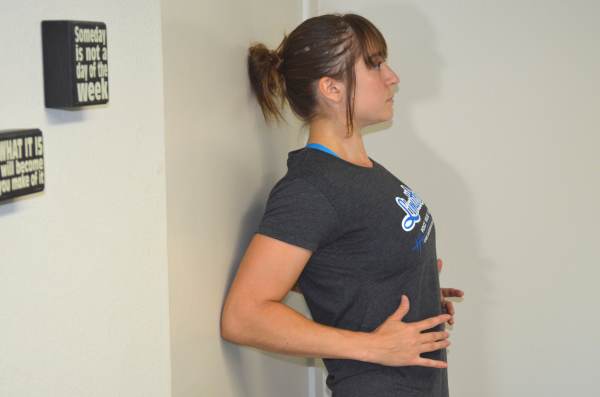
– Lying Bat Wing – The Lying Bat Wing is a variation of the Scapular Wall Hold done lying face down on a bench. It is a great option if you have super tight and overactive traps and you can’t get them to relax when doing the Scapular Wall Hold. This move can also be weighted down unlike the traditional Scapular Wall Hold.
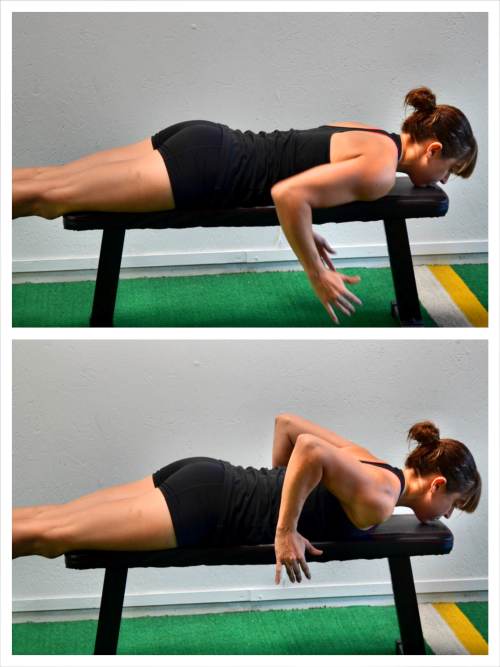
To do the Lying Bat Wing, lie face down on a bench or box. You can squeeze your butt to protect your low back.
Lift your arms up by your side, driving your elbows back and up toward the ceiling as you pinch your shoulder blades down and back.
Do not shrug your shoulders as you drive your elbows back. Keep your glutes engaged so you don’t feel this in your low back.
Hold at the top for a second or two and feel the muscles between your shoulder blades working to lift.
You can either do an isometric variation and hold at the top or you can complete repetitions. If you do repetitions, still move slowly and hold for a second or two at the top.
If the bodyweight move is easy, you may want to add weight, especially if you include the move in your workout as a supplemental exercise instead of just an activation move.
– Lat Pulldown Hold – This is a great scapular retraction and lat activation exercise for at home or when you travel because it can be done with bodyweight or a towel.

Grab a towel with both hands about shoulder-width apart and pull your hands away from each other so there is tension on the towel. Then press the towel overhead, keeping the towel taunt between your hands.
Press your chest out and pull the towel down toward your chest, pinching your shoulder blades down and back as if you were doing a pull up to the bar. Drive your elbows down to the ground as you pull the towel down keeping it tight between your hands.
You can either hold at the bottom of the pull or complete repetitions. If you do repetitions, move slowly and make sure to maintain tension on the towel the entire time.
If you don’t have a towel, you can do this with just your bodyweight. Without a towel, you will have to focus on pressing your chest out and driving your elbows down toward the ground to create tension between your shoulder blades.
– Scapular Push Ups – Scapular Push Ups are a tough move for people especially at the beginning because they don’t have the mind-body connection to allow them to isolate the muscles between their shoulder blades. If you really concentrate on just pinching your shoulder blades together without bending your elbows or moving your core, you will learn how to retract your shoulder blades so you can activate your lats during a pull up.
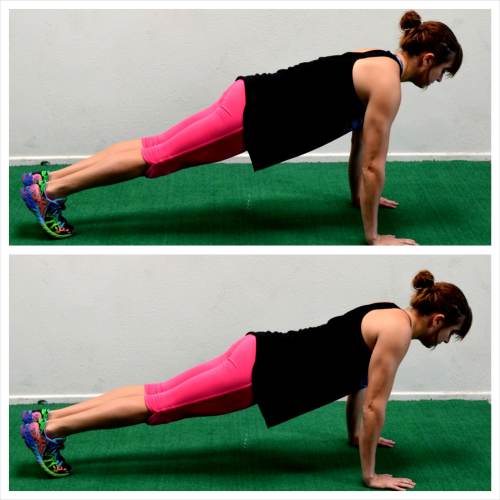
To do Scapular Push Ups, set up in a high plank position with your hands under your shoulders and your feet together as if you are going to do a push up. Your body should be in a nice straight line from head to your heels.
Then, without bending your elbows, press your chest out and pinch your shoulder blades together. Do not tuck your chin or allow your hips to drop toward the ground. Your elbows should not bend.
You are not doing a push up. You are simply pinching your shoulder blades together. This move has a very small range of motion. All you are doing is pinching your shoulder blades together and then relaxing or even rounding your back up out of it (round your back at the top is another variation but can be very useful for correcting certain push up problems).
If done right the Scapular Push Up should be felt in your back as well as your core.
– Inverted Row Hold – Another variation of the Scapular Wall Hold, the Inverted Row Hold can be done off a Suspension Trainer or a bar.
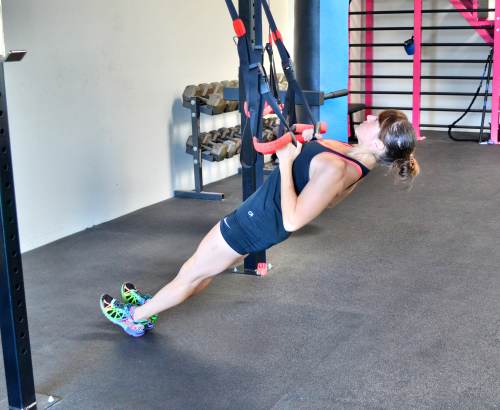
To do the hold off a Suspension Trainer, hold a suspension trainer strap in each hand.
Walk your feet out so you are leaning back. The closer to parallel to the ground you get, the harder the move will be. Squeeze your core and glutes and press your chest out so there is tension between your shoulder blades and your body is in a nice straight line from your head to your heels.
Your arms should be out straight in front of you holding the straps. Then row up, driving your elbows down and back while keeping your body in a nice straight line.
Row until your chest comes up to the handles and hold there.
Do not let your butt sag toward the ground or your hips arch as you hold. Do not start to turn your hands in and flex your wrists. Keep your hands and wrists in line with your forearms.
Also make sure you aren’t shrugging your shoulders as you hold. Drive your elbows down and back and keep your chest pressed out.
– Cobra – This is another great activation exercise you can do with no equipment. If you want to work on your pull ups at home with no equipment, the Cobra is a great move to include.
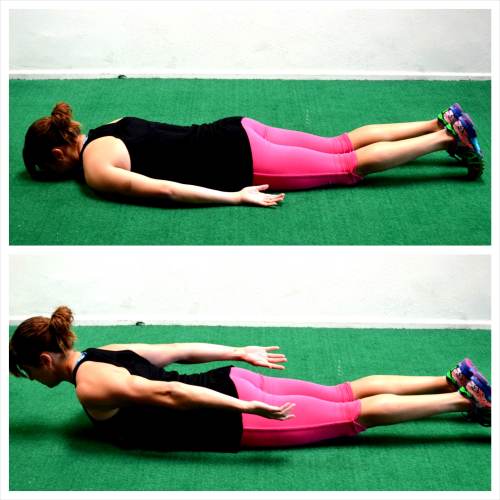
To do the Cobra, lie face down on the ground with your arms by your sides and your legs relaxed out straight.
Squeeze your glutes to keep your low back from doing all the work and pinch your shoulder blades down and back to lift your chest up as high off the ground as you can. Keep your head in line with your spine as you raise.
Draw your shoulder blades down and back and really try to get your chest high off the ground. You may find it helps to think about reaching your hands toward your feet as if you are trying to grab them.
In that raised position with your chest off the ground, you can either perform an isometric hold and hold at the top of the Cobra or you can lift and lower for reps. Even if you perform reps, hold for a second or two at the top.
If you want to make this move a bit more challenging, you can hold light dumbbells in your hands. Light weight is all that is needed if any weight is even added. It is about activation NOT about really building up these muscles.
– Posterior Plank – The Posterior Plank is a great move to activate your entire backside while also stretching out your chest. Being able to keep your core engaged as you lift can make pull ups easier.
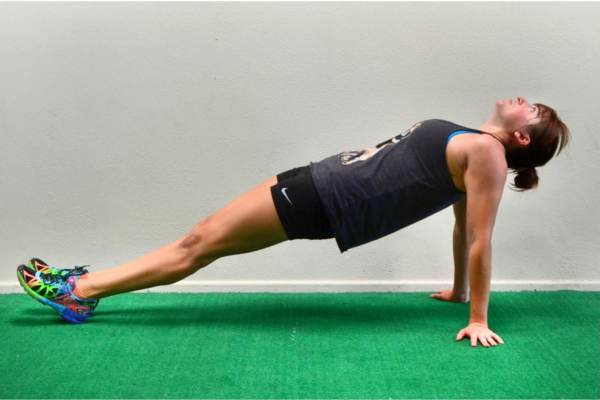
Sit on the ground with your legs out straight in front of you and your hands down behind your butt on the ground.
Then, driving up through your heels and your hands, press your hips up toward the ceiling and press your chest out. Lean your head back as you bridge up.
Squeeze your butt and lift your hips up as high as you can while keeping your legs straight and your chest pressed out. Hold at the top of the move with your body in a nice straight line. Make sure to keep your abs tight so you don’t hyperextend your low back.
Consciously squeeze your glutes at the top and press your chest out. While you want to feel your glutes working, you also want to feel a nice stretch through your chest and shoulders. And as you press your chest out, you should be drawing your shoulder blades down and together to activate your back.
If the Posterior Plank is too much, you may want to try the Table Top Bridge. Also, here are variations of the exercises that you can do at your desk – 10 Desk Exercises.
– Scapular Band Flyes – There are 3 variations of Scapular Band Flyes and all of them are essential to improving your posture and working on scapular retraction.
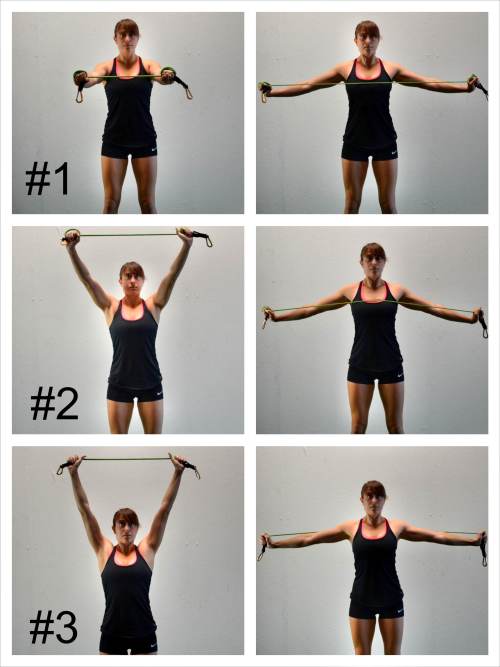
To do the straight on Scapular Band Fly, hold the resistance band with your hands about shoulder-width apart and press your chest out so you are standing nice and tall. Arms should be straight out in front of you at about shoulder height or right below. Keeping your arms straight, pull out on the band to open your arms out to the sides. Pinch your shoulder blades together as you open and bring the band in to your chest. Do not let your shoulders shrug up as you pull the band. Once you open the band to your chest with your arms straight, bring your arms back together so your arms are about shoulder-width apart again and there is no slack in the band. Repeat the fly. Do not let the band pull you. Move slowly with it under control. If you have to bend your arms to do the fly or if your shoulders shrug up, you may want to go lighter.
To do the overhead angled Scapular Band Fly, you will hold the band overhead in front of you and pull your arms out and down as you draw your shoulder blades down and together. Your arms should stay straight the entire time as you bring the band down to your chest.
The third Band Fly is an overhead move in which you will pull the band down back behind your head. Hold the band with your hands about shoulder-width apart. Press the band up overhead. Then pull your arms down and out to pull the band down toward the back of your shoulders. Keep your chest pressed out and draw your shoulder blades down and back as you pull the band down and your arms go straight out to the side at about shoulder height. Once the band reaches your shoulders, slowly bring it back overhead.
Isometric Pull Ups or Pull Up Holds are another great way to activate your back. They are also a great way to strengthen each piece of your pull up AKA you can use the pull up to strengthen the pull up.
Pull Up Isometrics – Pull Up Hold Variations
These holds can be used for activation and to work on the weak points in your pull ups. Pull Ups can be their own best supplemental exercise especially when you do holds to work on the weakest points!
On your last rep do you fail to budge from the bottom of the pull up? Then try a Dead Hang.
Or maybe you struggle to lock out at the top of your pull up. Then try a Pull Up and Hold.
The Mid-Pull Up Hold is another great move to really get your back and arms engaged and working. You can do it at the point you usually get stuck at or even right above that point.
All three Isometric Pull Up Moves are a great way to activate and strengthen your back in a functional way for pull ups. To do the three holds:
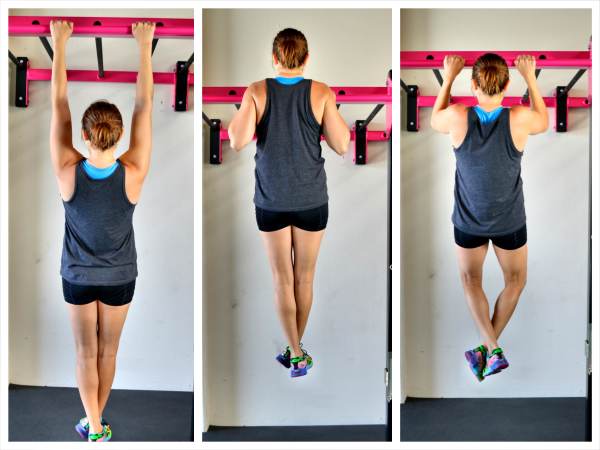
- Dead Hang – This move isn’t simply hanging from the bar. It should help you work on scapular retraction and activating your lats right from the bottom of the pull up. To do the Dead Hang, grab the bar and hang. You should feel like your shoulders are a bit raised as you hang from the bar. Then press your chest up and out as you draw your shoulder blades together. You should feel like your shoulders sink down and your neck elongates as you retract your shoulder blades. Feel your back work as you hang there with tension. This move will also improve your grip strength for pull ups.
- Pull Up and Hold – The Pull Up and Hold is a tough move and a great way to work on getting your chin up over the bar at the top, which is the hardest part for most people. To do the Pull Up and Hold, start hanging from the bar in a dead hang (aka with the muscles engaged). Then pull your chest up to the bar, or at least your chin over the bar, and hold. Keep your core tight and do not tuck your knees into your chest. Make your back and core really work with this move. Do not let your shoulders start to shrug as you hold. If you start to lose the hold, lower yourself down as slowly as you can and then perform a dead hang for a few extra seconds. If you can’t pull up to the top to hold, jump up or use a box to step up at the top of the movement.
- Mid-Pull Up Hold – The Mid-Pull Up Hold can really be done at any spot along the entire Pull Up movement. Set up where ever you tend to fail, or right above that spot, and hold. Make sure you don’t shrug or tuck your head as you hold. Really try to lead with your chest and feel the muscles of your back working.
All of these holds can be done with a variety or grips. You do not need to do a Pull Up grip every time.
Also, with all of these holds, you can do assisted variations if you can’t yet hold all of your own bodyweight. We prefer that you use your feet or a machine instead of bands to assist with the holds.
Pull Up Form
No matter how much stretching and activation you do, no matter how strong your back is, the only way to get better at doing pull ups, is to do them.
And while Pull Ups seem simple, there is more form than you realize to pulling your chin up over the bar.
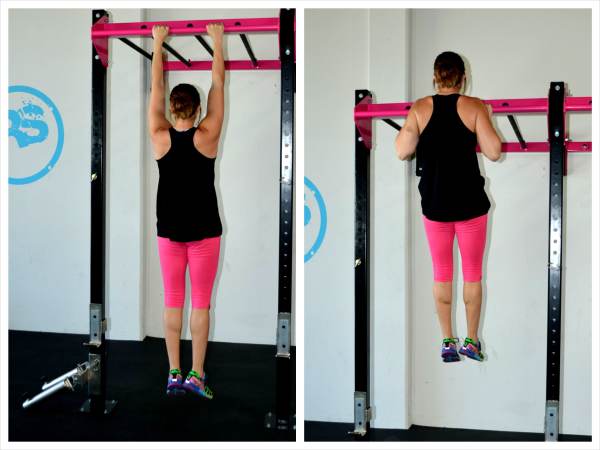
To do a Perfect Pull Up, start hanging from the bar with your palms facing away from you. Hanging with your arms straight off the bar, press your chest out and up and feel your shoulder blades draw down and together.
Leading with your chest, pull yourself up to the bar. Ideally you want to bring your chest all the way up to the bar as you draw your shoulder blades down and back.
Then slowly lower yourself down until your arms are fully extended.Your arms should fully extend at the bottom but you do not want to relax the tension in your back. Make sure to lead with your chest and do not let your shoulders shrug.
Do not bounce or swing at the bottom. You do not want to use momentum to pull back up.
Only on the last couple of reps should you ever swing at all or kick your legs. You want clean reps, but to eek out an extra rep or so and go past failure, you can use a little momentum.
Pull Up Variations
Beginners may not be able to do even one full Pull Up so will want to start with an Assisted Pull Up Variation.
These assisted variations take some of your weight off your arms and back until you are ready to handle more weight. They also allow you to do pull ups since you need to actually do pull ups to get better at them.
Beginner Pull Up Variations:
Our preferred assisted variations are the first three moves shown below. We prefer any type of foot-assisted variation because it is easy to control the assistance and we’ve found that spending more time under tension also really helps to build the Pull Up.
– Foot-Assisted Pull Ups – These can be done from a bar or Suspension Trainer. You just need something low enough that you can place your feet on the ground to assist you.

Hang from the bar or trainer and place your feet flat on the ground in front of you or your toes right behind you. Either foot position works, just make sure you set up so you can pull straight up without arching your back or letting your hips come up and forward. You don’t want a huge arch in your body or to turn this into a row. You want a vertical pull.
As you hang at the bottom with your arms straight, press your chest up and out to retract your shoulder blades. Leading with your chest, pull yourself up.
Use your feet only as much as needed to pull up. Your goal is to use your arms as much as possible. Pull your chin all the way above your hands and try to get your chest to your hands.
Then lower back down, fully extending your arms at the bottom.
You can change up the tempo of this movement. Our favorite tempos are either slow up and down or quick up 3-5 count down. Going up and down quickly doesn’t do near as much. You can also do a short hold at the top.
– Eccentric Focused Pull Ups – A great way to really develop your Pull Ups is to focus on slowing down the Eccentric portion or the lowering down portion of the movement.
If you can do full Pull Ups, focusing on the Eccentric portion can help you be able to do more. For this move, you will pull yourself up to the top and then just focus on really slowing down the lower down to a 5 or even 6 count.
The point is to focus on the lowering down and slow it down as much as possible no matter how you get to the top of the Pull Up.
To get to the top of the Pull Up, you can also do a Jumping Pull Up or even a Foot-Assisted variation if you can’t pull yourself up. This will still help you work a little on the Concentric portion instead of just setting up at the top of the Pull Up, which is also an option, but makes the movement an Eccentric ONLY move.
Once at the top of the Pull Up, you will lower yourself down as slowly as possible.
If you are doing the Foot-Assisted variation, you can keep your feet on the ground; however, this is also a great way to start taking on your full body weight. If you can, use your feet to lift to the top of the Pull Up and then lift your feet off the ground as you lower down as slowly as possible.
If you can no longer control the tempo down, you may want to again use your feet. You want more time under tension when focusing on the Eccentric.
If you do a Jumping Pull Up, you will have assistance up to the top of the move, but will take on your full weight as you lower down.
The slower you can lower down, the more you will get out of this move!
– Jumping Pull Ups – Jumping Pull Ups are another foot-assisted variation; however, instead of using your legs through the entire movement, you are trying to get your arms and back to work, especially to lock out and lower back down.
The more force you put into your jump, the easier the move will be.
Most often we use Jumping Pull Ups when we are focusing on the Eccentric portion of the move.
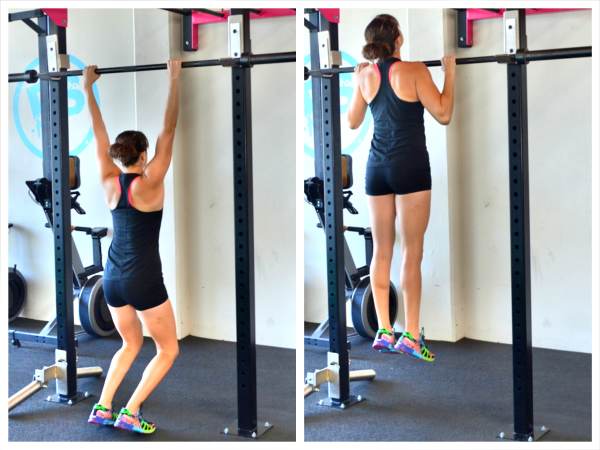
To do a Jumping Pull Up, set up under a bar that is high enough off the ground that you can hang from it, but low enough that you can use your legs to help get your chin up over the bar.
Hang from the bar with your feet flat on the ground. Then jump, and at the same time, pull yourself up with your arms to get your chin up over the bar.
Lower yourself back down, fully extending your arms at the bottom before you jump up again.
– Partner-Assisted Pull Ups – This is another foot-assisted variation; however, you are using your feet and your partner. If you find you struggle to get yourself to not use your feet on the ground, this may be a move you want to try.
You won’t want to push off your partner so you will force yourself to use your arms and back as much as possible.

To do the Partner-Assisted Pull Up, hang from the bar with your partner behind you. Bend your knees and place your feet in their hands.
Then, driving through your feet in their hands, pull up, using your arms and back as much as you can to lift you.
Your partner should try not to help you lift, but instead merely hold your feet firmly so you can press off as needed.
Then slowly lower back down once you’ve pull your chin up over the bar. Stay in control of the movement the entire time and try not to use your feet or your partner if you can.
– Machine-Assisted Pull Ups – If you have a Pull Up machine, you can also use that to assist you. However, when you use the machine, use as little weight as possible, even if it means testing out different weights to see when you hit failure.
While it can be good to do some higher rep ranges with more assistance, it is also important to do lower rep ranges with as little assistance as possible.
If you never start trying to do your bodyweight, you will never be able to do a full Pull Up, which is why you see some people perpetually stuck on the Pull Up Assist Machine.
– Band-Assisted Pull Ups – Bands are another great way to add assistance to the Pull Up; however, they aren’t our favorite because they provide more assistance at the bottom of the move, where you don’t need it as much, and less at the top, where most of us need it.
However, they are what you have available to you, they can still be used to help you work on your Pull Ups. And the more variations you can use to work your back and arms in different ways, the better off you will be.
To do the Band-Assisted Pull Up, you will hang a band from a Pull Up bar and the place your knee (or knees or foot or feet) in the band. One knee is most challenging, two feet is most assistance. You will then pull up to the top using the band for assistance.
Make sure to still lead with your chest as you pull and retract your shoulder blades at the bottom. Do not simply depend on the band.
Use as light a band as possible so that you challenge yourself as much as possible.
Pull Up Grip Variations:
Varying your grip can also make the Pull Up harder or easier. It can also target slightly different aspects of your back and engage muscles to different degrees.
For instance, the Chin Up Grip is supposed to be easier because it engages more bicep. Just like the Wide Grip Pull Up is traditionally harder because it is all lat. You may find that certain grips are easier for you than others; however, you should include a variety of grips in your upper body workouts to work your back, biceps and grip in different ways.
Below are 5 basic grip variations:

- Pull Up Grip – Palms facing away on the bar about shoulder-width apart.
- Chin Up Grip – Palms facing toward you about shoulder-width apart.
- Neutral Grip – Palms facing each other about shoulder-width apart.
- Wide Grip Pull Up – Palms facing away with your hands wider than shoulder-width. You can go super wide, holding as far out as your arms allow.
- Close Grip Chin Up – Palms facing you with your hands closer than shoulder-width apart. You can even place your hands right next to one another.
Supplemental Exercises To Improve Your Pull Ups
While you need to do Pull Ups to get better at them, you also need to strengthen the muscles involved to be able to do more and even do advanced Pull Up variations.
These Supplemental Exercises will strengthen the big muscles of your back as well as your biceps, core and grip. They are a great way to work the muscles involved in Pull Ups in a variety of ways.
– Dumbbell Pull Overs – Dumbbell Pull Overs are a great way to work your lats and core. If you do them from a bridged position instead of lying fully on the bench, you will also really work your glutes and even your hamstrings.

To do the Dumbbell Pull Over, place your upper back on a bench or box. Grab a dumbbell in both hands and bridge your hips up.
Keeping your arms fairly straight with only a slight bend to the elbow, reach back over your head toward the ground behind you. Reach back as far as you can and then bring the dumbbell back forward over your chest.
Keep your hips up the entire time.
Really feel your lats and abs stretch and work to control the reach overhead. Then feel your lats and abs work to pull the dumbbell back over your chest.
Do not turn this into a tricep exercise. Keep the arms straight and do not start to bend at your elbows.
If you can’t reach very far back overhead, you may want to use a lighter weight.
Concentrate on feeling your lats work to pull the weight back over.
– Standing Lat Pushdown – This movement is basically a standing Pull Over. It can be done with a resistance band or cable pulley machine.

To do the Standing Lat Pushdown, anchor the band and bar up high and hold the bar in both hands with your back to the anchor point. Again you can also use a cable pulley machine.
Step away from the anchor point and extend your arms up overhead. You want tension in the band with your arms up overhead so that there is tension through the entire push down in front.
Stand nice and tall with your feet about hip-width apart and your chest pressed out. Do not let your low back arch. Make sure your abs and glutes are engaged.
Then, maintaining a nice tall posture, press the bar down in front of you, keeping your arms straight. Feel the sides of your back and your abs, working to push the bar down in front.
Press it down to your hips and then extend your arms back overhead.
Keep your chest up and your core tight then entire time you press the bar down. Feel your lats working to pull the bar down and over in front.
Move slowly and step further away if you want more tension in the band.
You can also do this facing the anchor point for a straight Lat Pushdown.
– Inverted Rows – Rowing exercises are a great way to work your rhomboids and develop the strength to do more Pull Ups. Inverted Rows have also been considered a great Pull Up regression since they force you to lift your own bodyweight with your back.
However, since they aren’t a vertical pull, rows alone won’t get you to a full pull up, but they are a great supplemental move!
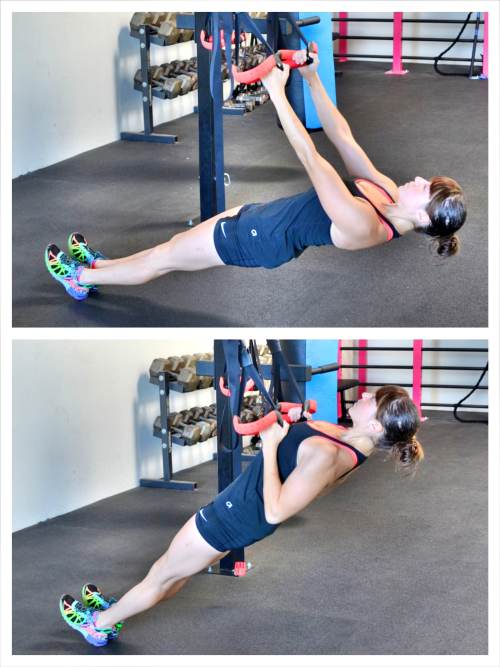
Check out this complete guide to Inverted Rows and variations – The Inverted Row.
– Single-Arm Dumbbell Row – The Single-Arm Dumbbell Row is a great unilateral move to build back strength and correct imbalances.
For this row, you can set up in a variety of ways. Below we will go over the single-arm row with your knee and hand on the bench.
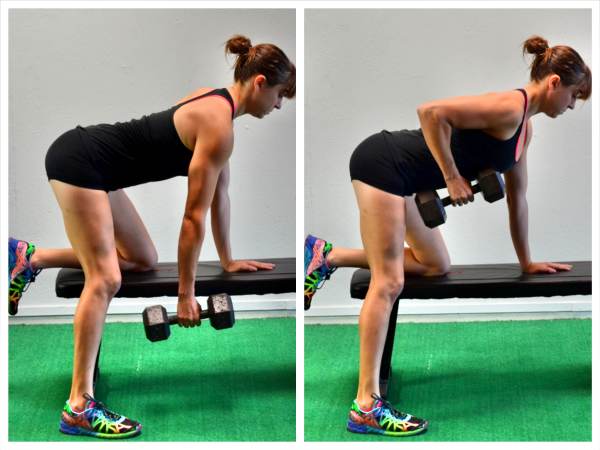
To do the Single-Arm Dumbbell Row, set up with one knee and hand on a bench or box. If you are going to be rowing on your right side, your left knee and hand will be on the bench.
Press your chest out and feel the muscles of your back activate. You want your back to stay nice and flat as you row.
Hold the dumbbell in your right hand with your right foot on the ground.
Keeping your back flat, row the dumbbell up to your side. Drive your elbow up and back as you row and do not let your shoulder shrug.
Feel the right side of your back working to row the dumbbell up. Do not row the weight up to your neck. Bring it in to your side at, or just below, chest height.
Do not rotate a lot or swing to lift the weight.
Once you’ve rowed the weight up, extend your arm all the way back down. Do not reach past full extension to try to drop the weight closer to the ground. You do not want to relax your back at the bottom of the row.
Complete all reps on one side before switching. Slow down the tempo or add more weight to make the move more challenging.
– Med Ball Slams – Med Ball Slams are a great exercise to develop lat and core power. They also really get your blood pumping!
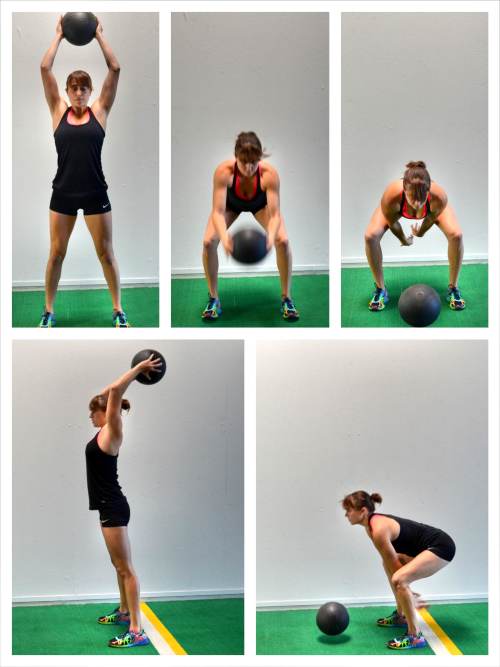
To do Med Ball Slams, stand nice and tall with your feet between hip-width and shoulder-width apart. Hold the ball in both hands.
Reach both arms up overhead, fully extending your body and standing tall.
Then slam the ball toward the ground, hinging over as you do. You will slam the ball and sit your butt back.
To slam the ball, you are almost performing a pull over type motion.
Then squat to pick the ball back up and reach back overhead. Do not just pick the ball up with your back. Squat to pick it up.
Move quickly through the reps, slamming the ball as hard as possible.
If the movement isn’t explosive, you may be using too heavy a weight. This isn’t a strength movement. It isn’t about how much weight you can lift.
It is about moving quickly with a load. The med ball should be light so you can be explosive.
– Lunge with Lat Pulldown – Lat Pulldowns are one of the best weighted supplemental exercises out there because they are a vertical pulling exercise that really works your lats.
Even if you don’t have a Lat Pulldown Machine, you can do a Lat Pulldown with a cable pulley machine or resistance band.
When we do a Lat Pulldown with a resistance band, we like to add in a lunge.
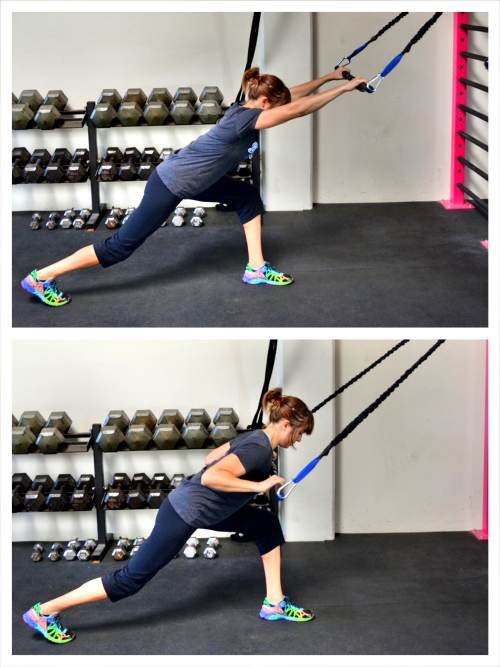
To do the Lunge with Lat Pulldown, anchor the band up high. Then grab the band in both hands with your palms facing away. (Just like with the Pull Up, you can use a variety of grips.)
Step back and sink into a deep lunge with the back leg straight. Lean forward over the front leg, keeping your back flat and reach your hands up overhead holding the band. You want to create a nice straight line from your hands to your tailbone so that you can mimic the vertical pull.
Then pull the band down to your shoulders, driving your elbows down toward your hips. Feel your shoulder blades retracting and the sides of your back working to pull the band down
Keep your chest pressed out and your core tight as you pull the band down. Do not let your back round just to pull the band lower.
Extend your arms back overhead and repeat.
Make sure to keep your back flat and draw your shoulder blades down and back as you pull the band down to you.
Step further away from the anchor point to increase the tension and make the move harder. You can also slow down the tempo of the move to make it more challenging or use a heavier band.
Pull Up Variations – Pull Ups can be their own supplemental exercise.
You can use different grips. Or change up the tempo and focus on the Eccentric, Isometric or even Concentric pieces of the lift. Or even do holds.
And if you can do full Pull Ups, you may even want to try harder variations or play around on the monkey bars. Monkey bars are a great way to develop lat, grip and core strength!

Remember though, you only get better at doing Pull Ups by doing Pull Ups. So while you want to do these other supplemental exercises to strengthen your grip, arms, back and core, you also want to include Pull Ups as often as you can in your routine!
If you want to do more Pull Ups, you need to use all of the pieces included in this guide. You need to design workouts that include foam rolling, stretching, activation, pull up variations and supplemental exercises.
You should even do back foam rolling, stretching, activation and strengthening moves 2 or 3 times a week. This will not only improve your pull ups, but will also help you prevent neck, shoulder and upper back injuries from sitting at a computer all day!
How are your Pull Ups? What are you doing to improve them?
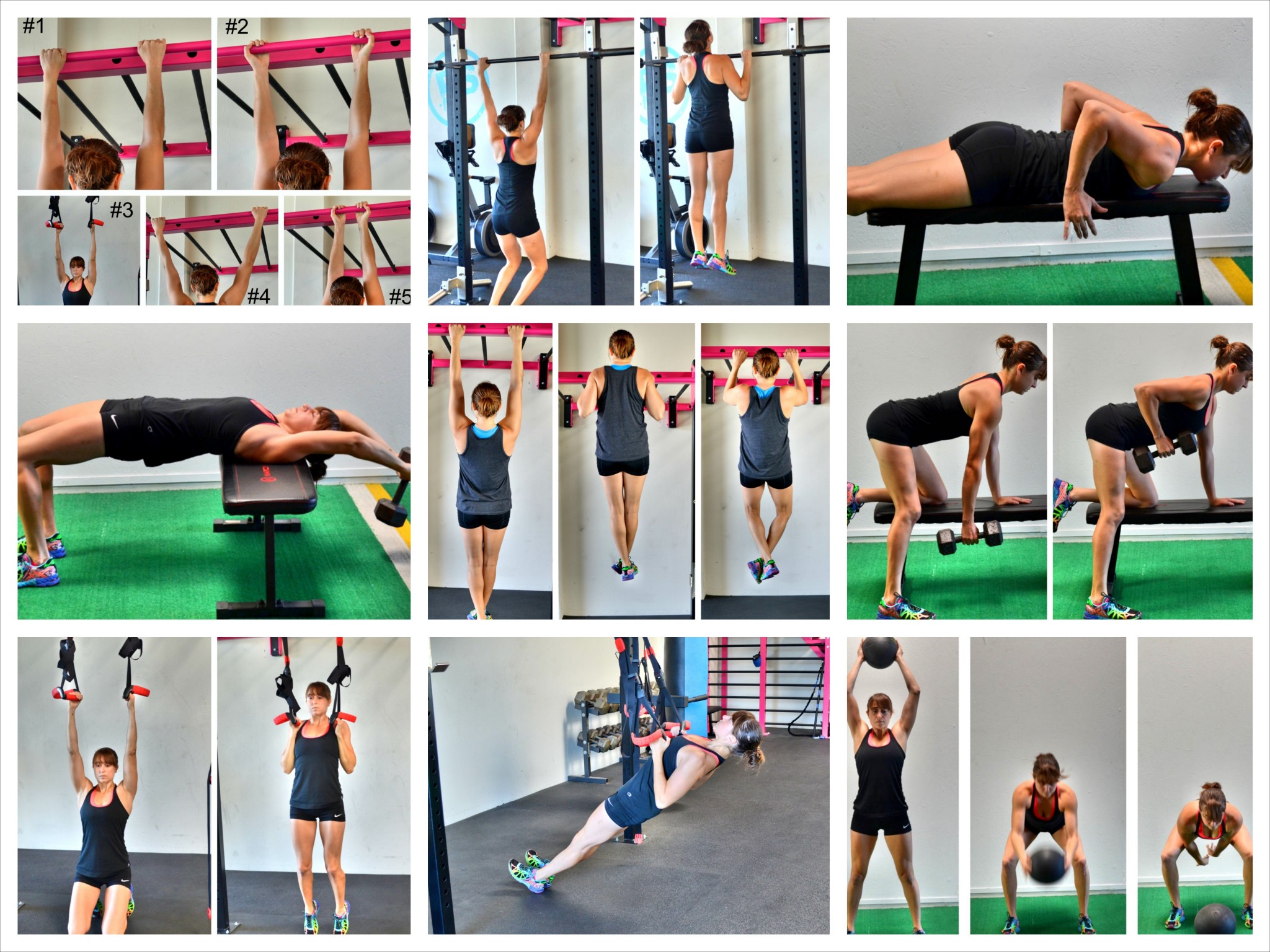
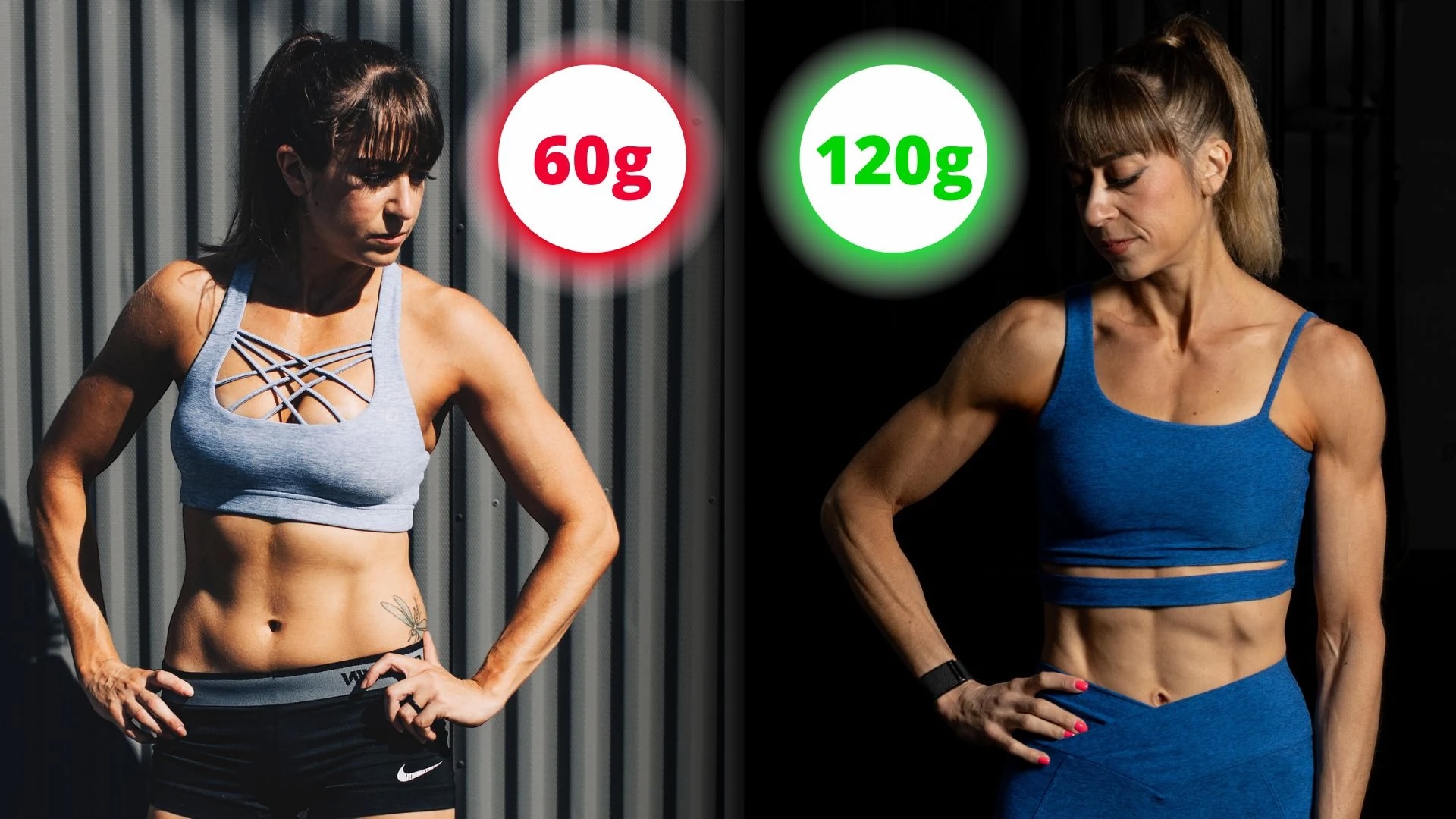

tons of information!!!thanks!!
Love, love, love this page! Thank you!
Thank you Nancy! If you need anything, let me know. Cori
Great information, many thanks.
No problem! Hope it helps and if you need anything else, let me know!
i can do negatives for a long hold and can get 1/2 way up on the pull up but still can’t do a full one .
I’d try some pull up holds right at and above your stick point 🙂
Very useful, thank you!! I’ll try to do it the right way you suggest
Glad the tips help Chiara!